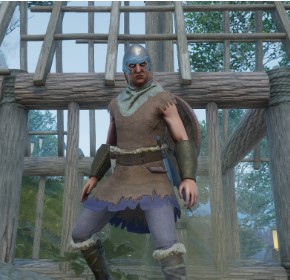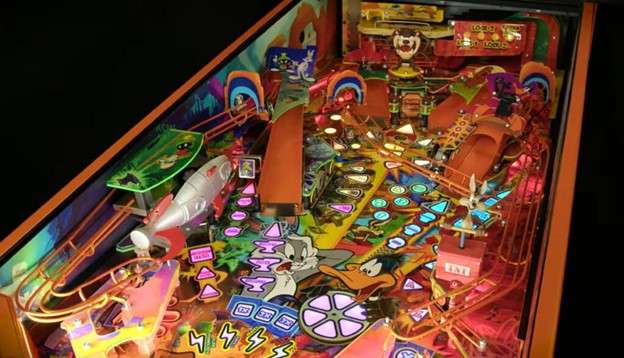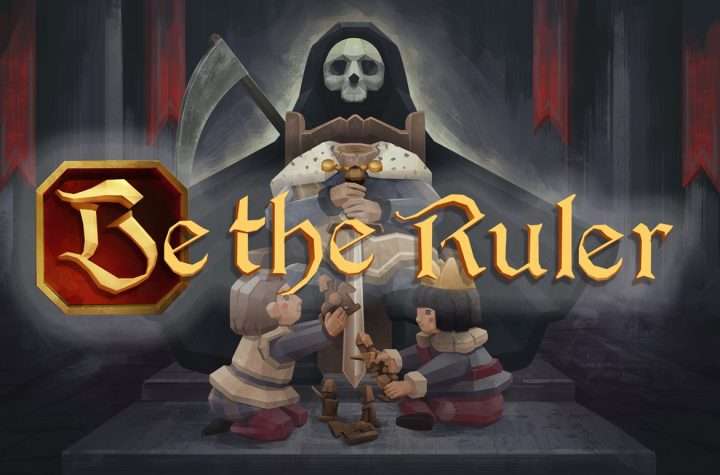
From the earliest days of Gaming, hacking and slashing through enemies and surviving gauntlets of deadly opponents has had an incredible allure. Over time, the capabilities of both the player and the enemies would be expanded as hardware became less limiting, leading some masochistic developers to ask the question “what if the enemies were always more powerful than you?” Enter the Souls-like, a genre defined by its original game, Dark Souls. These grueling games are near-constant endurance tests against legions of overpowered underlings leading up to confrontations with the behemoths that force even these deadly minions to kneel. But, as time has gone on, the challenge of a Souls-like wanes as its map is studied, scrutinized, and memorized. Its enemy placement can be predicted and planned around, its items and equipment can be located and placed onto the safest route possible. Randomizing these games has been a staple for thrill seekers trying to recapture the challenge of first entering into the game without any knowledge.
Ravenbound, by the developers at Systemic Reactions, aims to scratch that itch while providing additional new takes on the mechanics of a Souls-like. Your character, who you chose out of 3 random options at the beginning of each run, is chosen as the Vessel of the Raven, and its up to you to use its godlike power and your sheer determination to overthrow The Betrayer. With the Raven’s Talons grappling hook and the ability to transform into a Raven to fly around the map, there’s no limit to where you can explore. …except for the creatures overtaken by the Betrayer’s plague, which is called Hatred.
You’ll be able to duel these foes with a multitude of weapon classes, such as a traditional sword and shield or with two war axes. Strike quickly to build up your focus, then unleash it once fully charged for a boost to your attack. You can also use slightly more patience and deal heavier damage, as well as filling your opponent’s stagger meter more quickly. Block your enemy’s strikes with a shield made out of your essence, just take care not to let it shatter and leave you defenseless. If you time your shield just right, you’ll knock back opponents and become temporarily invincible! You can also dash out of the way of your enemy’s attacks, and doing so at the right time speeds up your attacks for a short while.
Taking down strong enough enemies will drop you fragments, which are incredibly useful. After obtaining three, you can cash them in to access Ravenbound’s main gimmick: the loot deck. Using these fragments offers you a choice of three possible cards, each with a different effect. Some cards are different weapons or armor to equip, while others are passive abilities. Sometimes you might even find cards that do something upon activation, such as upgrading your equipment, increasing your stats, or even instantly giving you some resources. These cards aren’t free, though: most of these require Mana to activate, and Mana is itself a very rare resource that you can only obtain from the cards. It becomes an interesting balancing act of what abilities to apply, what cards to take, and how much danger you’re willing to face in exchange for more options and chances for Mana. Remember, healing isn’t cheap.

This system is complicated by the aforementioned Hatred. It isn’t just the people and the land that The Betrayer has corrupted, they’ve even gotten to the loot! Most of the time, when you go to open up a chest or claim some leftover goodies from another player’s run that went awry, you’ll find yourself required to take Hatred fragments first. These replace one of your card draws with a guaranteed Hatred card, which instantly makes the rest of the world a more dangerous place to explore. You’d think that taking too many of these cards would be what filled up the Hatred meter, which permanently forces one of your cards to become a Hatred card. You’d be wrong. Apparently, using fragments at all increases this meter, meaning that grinding for fragments is self-sabotaging. This formula decreases your options over time while simultaneously making it impossible to pick up loot without punishment.
The loot deck mechanic of Ravenbound is something that I found very interesting and enjoyable to use. The way that it required you to tactically think about what to take and when to use it was very fun. However, you don’t have to play for long before some of the flaws of Ravenbound begin to become very apparent. For example, you’ll quickly realize that defeating enemies and looting the world is either painfully slow or needlessly punishing: your character starts out relatively weak, and you’ll need to upgrade yourself to stand a chance. However, the only ways to get stronger is to take down enemies or to loot anything you can find. The problem with this is that there’s no effective way to remove Hatred from the chests you find around the world in a quick enough way or large enough radius to be worthwhile, meaning that you have to either grind to get stronger without risk (time consuming and boring) or take the loot despite the Hatred (extremely punishing). And the game even seems to incentivise this riskier approach, since every enemy encounter drops two fragments and every Hatred-cursed chest and loot pile gives you a single Hatred fragment. You can draw more cards by playing it risky than you could by being careful, even though these cards would tend to be worse for you.

On the subject of these enemies, they aren’t the smartest in the world. I can’t tell if its the Hatred that’s eaten away at them, or if they legitimately don’t realize that you can’t hit somebody standing on the roof of their own house from the floor. Also, you won’t really see too many different types, at least those that you’ll be able to actually stand a chance against. I spent nearly 30 minutes encountering only different possessed humans with different types of axes and swords before I wandered into a high-level area and was completely destroyed by tree people. Thirty minutes later, I’d managed to encounter two more types of enemies, (those being low level goblins or imps and some extremely powerful witches that instantly destroyed me), and the first boss, who was a humanoid creature in black armor who I was entirely unable to defeat. I honestly couldn’t tell if I was under-preparing for the boss, over-cursing myself with Hatred debuffs, or if the boss is just that unfair.
Many features of the game feel unintuitive, as though they could use a complete revision or two. As I mentioned earlier, you can use either a light or heavy attack, but you can also charge these attacks. The game provides a tutorial on how to charge the heavy attack, as it is required to break through when an enemy blocks. (How that block affects the entirety of their body even when facing away from you, I couldn’t tell you) However, the game doesn’t spell out that you can also charge your main attack for a quick barrage. More shockingly, the game never tells you that you can just tap the heavy attack button to use a heavy attack, instead only teaching you about the charged attack. I honestly thought that there was no point in using that button if an enemy isn’t guarding before I accidentally hit something. Speaking of that heavy attack, something so strong that it can break through an enemy’s guard… deals minimal damage. You’re better off just spamming your quick attacks, its quicker and more effective. The grappling hook also only throws in a set arc based on where your character is looking instead of being tied to any kind of crosshair or the camera’s orientation. It felt like you should be able to quickly chain hook throws on the ground to pull yourself around the map at an equivalent pace to your Raven form. Instead, you’ll throw the hook, sluggishly wait for it to land on the ground, then pull yourself forwards 3 feet. Congratulations, you’ve nearly doubled how long it would’ve taken you to go forwards if you’d just kept walking. This would be a non-issue, except that just walking is boring. And you’ll be doing quite a lot of walking, considering that while you can turn from a raven into a human at any time, you have to go to specific points on the map to turn back into a raven. The landscape is mostly flat, so enjoy the slog to your “Raven Tower.” (which is mostly just a pedestal for a “holy” wind gust) It makes sense that you don’t take fall damage, considering the fastest way to get somewhere is to fall down the closest pit on the way there and hook your way back up.

Overall, there’s something here. Ravenbound isn’t a bad game. Its mechanics are well tuned and optimized, but inconsistently so. Parts of the game feel great, like the beginning sequence. But for every upside there’s a downside that overshadows its good ideas. The idea of a randomly generating souls-like world is fascinating, but when the upshot is just making the key locations randomly further away and making any genuine understanding of the map or the world meaningless, it becomes unworthwhile. Graphically, the same can be said of the game. When the game takes its time and sets up a scene, it can be beautiful. I was overjoyed when I saw how pretty the game could be while walking alongside a reflective river, listening to the wind whistling through the trees. But then I get pulled back to reality by looking at my character, who’s less Geralt of Riviera and more George of Costanza.
Check out the Ravenbound launch trailer:
I know that there’s promise here, but it’ll take a little digging for the developers to truly hit their stride and optimize this game into the genre-blending masterpiece that I can tell the game wants to be. But as it is now, I’d say to stick to games like the Middle Earth franchise for your dose of fantasy hack-and-slash. (Speaking of which, if Warner Bros. was ever interested in sharing the Nemesis system, it would fit into Ravenbound perfectly)
6/10. Not bad, but muddled and messy. With a bit of polish, an easy 8.
Ravenbound is available for PC via Steam. For more information, visit www.RavenboundGame.com, and keep up with the latest updates by following the team on Twitter, Facebook, Discord, and TikTok.
Related: Reviews by Aaron Grossmann
Gaming is a passion that I, like many other people, hold near and dear to my heart. As an aspiring Game Writer and general Storyteller, I enjoy looking into the vast worlds and deep stories of every game I can. Then again, sometimes bad guys just need a good pummeling, and I am more than happy to provide!





More Stories
Pinfest 2024 Overview
Play the Free Steam Demo Now for Be the Ruler: Britannia
Mutant Football League 2 Heading to Steam Early Access May 31